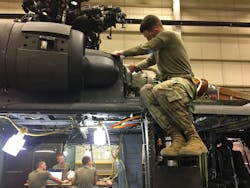Army Aviation Maintenance Takes on Training, Logistical Challenges
“Sixteen years of the Global War on Terrorism has really eroded our ability … to maintain our helicopters,” says a man in position to know. Gregory M. Chambers is the Command Sergeant Major (CSM) of the Aviation Branch at the United States Army’s Aviation Center of Excellence at Fort Rucker, Alabama. In conjunction with colleagues at the 128th Aviation Brigade at Joint Base Langley-Eustis in Virginia he helps fashion the nuts and bolts of maintenance training for Army maintainers.
Just now CSM Chambers is in the process of helping put the finishing touches on a program aimed at fundamentally changing the way rotary wing maintainers are trained. The aim: to produce more holistic technicians, maintainers capable of better troubleshooting problems. The aviation maintenance training program (AMTP) is “on track for initial implementation in FY ’19,” says Chambers.
“The [Aviation] Branch is very, very good at removing and re-installing a component on a helicopter,” says Chambers. A good example is the intermediate gearbox on the AH64E. The component is critical. It drives the tail rotor on the aircraft.
What maintainers have been less adept at is troubleshooting certain components, such as the General Electric T701 powerplant that propels both the Apache and the ubiquitous UH-60 Black Hhawk. “We’ve taken a lot of good engines off helicopters,” says Chambers, “where we thought there was something wrong, removed them and sent to the Corpus Christi Army Depot (CCAD) to have them repaired. The problem is when they put them on [diagnostic equipment] they couldn’t find a fault.” As a result he says, “The Combat Aviation Brigade spends a lot of money buying brand new engines.”
The solution: instilling understanding how a particular component works, not merely how to remove it and convey it on to CCAD. The intermediate gearbox once again illustrates Chambers’ point. The Army now wants soldiers to understand how exactly it works, how fast it spins, how it interacts with the driveshaft, and how it fits with the aircraft in its entirety. “It’s important that our soldiers understand the interaction with the helicopter [as a whole],” says the Command Sergeant Major, and how it’s dependent on other components in the aircraft.
Technology helps. The 128th Aviation Brigade at Joint Base Langley-Eustis is teaching military operation specialty (MOS) 15B engine maintainers via virtual means. “We teach them virtually how to tear an engine apart: the cold section, the hot section, the gas generating section, and how to remove an accessory module,” says Chambers. “We do it virtually first. We can ‘explode’ the engine visually and talk about all the parts and components. It’s so much more efficient than going out and trying to do this on a real engine.” The virtual exposure complete, “We take them out on the [hangar] floor and we teach the real task of (for example) removing the cold section of a T701 engine.”
Virtual training is a key component in the new AMTP, avoiding as much as possible the practice of taking a fully mission-capable aircraft out of service and employing it to train people.
The virtual approach is important, but there’s more to it than that. The mastery of Individual Critical Task List (ICTL) is even more important.
Task Masters
Every military operational specialty has specific ICTL. The shorthand for Black Hawk Mechanic in the Army is 15 Tango (15T). A 15T soldier must be proficient in a full 91 ICTL. One is removing and reinstalling the main rotor blade. A couple of other more extensive critical tasks are removing and reinstalling the inboard retention plate on the tail rotor gearbox and removing and reinstalling the main transmission on the Black Hawk. Along with mastery of mainline items like these comes a multitude of supporting tasks.
AIT (advanced individual training) of the type dispensed by instructors at the 128th Aviation Brigade is only the starting point of the learning experience. “How fast [the soldier] learns those tasks and becomes proficient in them is going to vary from soldier to soldier,” says Chambers. “We’re not going to put a time limit [on acquisition of those skills]. When they get proficient and signed off” they move on to the next task. Over time the resultant maintenance leaders learn to train the young soldiers who follow them.
Advancement through the ranks is the goal. You don’t want to go before the Army promotion board without being proficient in your particular MOS.
Perhaps the most critical task of all is perfusing this new training program through the ranks of the 19,000 or so enlisted soldiers that maintain Army helicopters across all three Army components — Active, National Guard, and Reserve.
Recapitalizing the Fleet
The operational tempo of commitments in Iraq, Afghanistan, and other theaters in the Global War on Terrorism means there are lots of helicopters awaiting recapitalization — essentially zeroing out the aircraft's powerplants, transmissions, and other critical components. Waiting to induct them are about 1,100 mostly civilian specialists working the Recap line at the Corpus Christi Army Depot (CCAD).
Overseeing that line, as well as managing the 3,400 people across the depot itself is Colonel Allan Lanceta, the facility’s commanding officer. Last year CCAD worked on 38 aircraft for the Army. “Between crash battle damage and what we do for the Air Force last year we did 41 helicopters total,” says Lanceta.
Before his arrival at CCAD it took, on average, 500 days to recap the average helo. His goal was to cut that to 350, and his commanding general said to shoot for 275. The depot complied, turning out one aircraft in a lean 274 days. The overall average now is “about 350 days,” says the colonel. “That’s a huge improvement,” almost cutting the days spent in Recap in half.
While the Army Aviation Center for Excellence focuses on presenting the big picture to young maintainers in an effort to save money and boost aircraft readiness, CCAD’s prime mission is to rebuild them. And that means getting the right parts to the right place at the right time.
“Parts take a long time to get here,” says CCAD’s commander. “The way it was before, when the aircraft got here we would see what parts, what materials they needed to get rebuilt.” It was a classic case of hurry up and wait. Now the depot adheres to the 80/20 rule. Because the CCAD has rebuilt hundreds of helicopters of a particular type before, it “should know the common parts that we’ve typically used in the past,” says Lanceta. “I have my team planning ‘left of induction.’ I have them looking [ahead] about 120 days at gathering the material.”
The result is to dramatically shrink “non-value added time.” It’s been cut in half. Pivotal to the overall nine-gate (phase) Recap effort is Gate 4, the structures station. Lanceta says by having the proper parts and tooling already set up and waiting CCAD’s been able to reduce the non-value added time at this gate “from 160 days to 120 days.”
Giving a sister service its due, Lanceta says he borrowed the program from the United States Air Force, and then tweaked it to fit the Army’s way of doing things.
Lanceta’s effort dovetails nicely with the Army’s Storage, Analysis, Failure and Reclamation program, or SAFR. According to a press release written by Kelly A. DeWitt, a public affairs representative with the Army’s Aviation and Missile Research, Development and Engine Center (AMRDEC), a pull-a-part shop at CCAD is saving money and boosting aircraft readiness.
DeWitt says, the program works by gathering specifically identified candidate parts from airframes being overhauled at CCAD. She quotes Michael E. Vourcos, a SAFR program engineer, “We select parts based on critical supply need, complexity to manufacture, raw materials availability, [and] long procurement lead times” typically those parts that no longer meet current repair criteria limits or are beyond economical repair. Engineers look at those parts and put together repair development solutions. Most common candidates to be returned to duty as usable are gearbox housings, transmission gears, engine blades, and rotor heads. Vourcos says, “Our repair development solutions typically reclaim 50 to 75 percent of the parts. This results in an average of more than 2,000 parts repaired and returned to service annually.”
CCAD’s mostly civilian workforce is looking to get the helicopters back to warfighters more quickly by speeding up access to needed parts and components. But there’s a teaching component to CCAD too. Sergeant Matthew Magreta, a CCAD public affairs contributor, penned an article that noted how Utah National Guardsmen of Company D, 2-211th General Support Aviation Battalion honed their pre-deployment skills “alongside seasoned depot-level aircraft mechanics and engineers.”
Magreta quotes Sergeant 1st Class Jesse Martinez as saying, “Our new soldiers need to get their hands dirty and expand their knowledge of aircraft maintenance before our deployment. We don’t get these kinds of opportunities back home.” At CCAD soldiers concentrate on engine assembly, composites, rotor blades, and structural and skid repair on the UH-60 Black Hawk, AH-64 Apache, and CH-47 Chinook. The idea is to boost maintainers’ confidence when they hit the ground overseas — to help young soldiers de-stress at least one challenge they’ll face by working things out ahead of time on the nurturing shop floor of CCAD.
The environment in which these men and women deploy is anything but nurturing. Like Vietnam, it’s a helicopter war this Global War on Terror. These days, “We’re either training or deployed,” says Colonel Lanceta. Those who fly these aircraft deserve the most reliable aircraft the Army can humanly provide. Nothing less will do.
About the Author
Jerome Greer Chandler
Jerome Greer Chandler is a two-time winner in the Aerospace Journalist of the Year competition's Best Maintenance Submission category; he won in 2000 and 2008. He received the Lifetime Achievement Award at the 2017 Aerospace Media Awards in Paris, France. His best-seller 'Fire and Rain' chronicles the wind shear crash of Delta Flight 191 at DFW.

